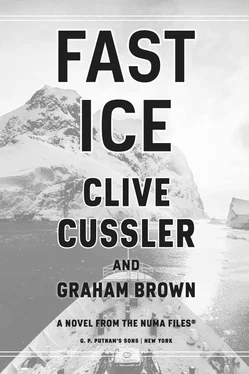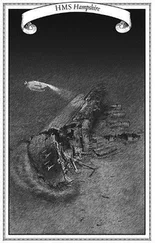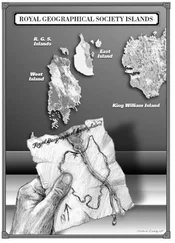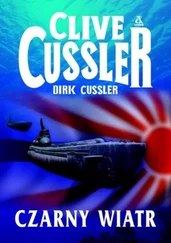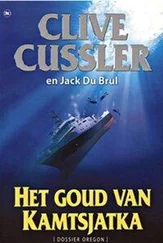Paul expected a text box to pop up, indicating what had been written and where, but instead the image blurred and then refocused. Overall, it looked identical to the original image. Every crease, smudge and stray ink mark remained where it had been before, only the words had changed from German to English. But even this was not accomplished in a clumsy, computer graphics style. It looked as if the ink on the page had magically rearranged its molecules into a new language. Even the handwriting looked the same.
Paul looked from the screen to the paper and then back to the screen. “Remarkable.”
Ms. Bauer beamed with pride. “It uses an artificial intelligence system and is accurate ninety-nine-point-seven percent of the time. It has even learned and translated many of the unique forms of shorthand and symbols some SS officers used. I believe you’ll find it quite helpful.”
Paul was impressed. “If we had this back at NUMA, it might be able to read Kurt’s chicken scratch.”
Gamay laughed. “What if it finds something it can’t translate?”
“In that case, the system will flag it,” Ms. Bauer told them. “We have human interpreters on staff who can help you. Or you can simply ask the system to guess.”
“Impressive,” Gamay said, pulling on a pair of gloves and settling in at a second terminal across from Paul.
Ms. Bauer waved a short good-bye. “I’ll leave you two alone. Contact me on the white phone if you need anything.”
The pile of folders waited. “I suggest we read through everything and then make a list of documents that might be helpful,” Paul said.
“Look at you,” Gamay said. “Choosing logic over going at this willy-nilly.”
“When have I ever done anything willy-nilly?”
Gamay laughed but said nothing. She was already pulling out her first document and sliding it under the scanner.
At first, she found herself mesmerized by the virtual translation. After a short while, she grew so used to the technology that it seemed totally natural.
Despite the advanced system, progress was slow. After an hour of work, they’d gone through only a quarter of the stacked folders, most of which related to ship movements and aircraft assignments.
The second hour brought them records from various vessels. This included more weather reports and bills of lading. The first sign they were getting anywhere came with the appearance of a familiar name.
“I’ve found some records related to the Schwabenland expedition,” Gamay announced.
“That must be where Cora started,” Paul said. “But I may have found something even more interesting. Look at this. It’s a photo of a second freighter that was originally supposed to join the expedition. There’s a communiqué here indicating it was left behind in Hamburg after a damaged boiler had to be replaced. It finally sailed”—he was looking for a date—“two weeks later.”
Gamay looked over the photo of the ship. It was an old freighter, similar to the Schwabenland, right down to the catapult and a pair of Dornier flying boats secured on deck.
“Hiram’s analysis of the photo ruled out any members of the Schwabenland air crew as being part of the photograph,” Gamay said. “But what if the people in Cora’s photo were on the other ship?”
“My thought as well,” Paul said.
“What’s the name of the ship?”
“The Bremerhaven.”
Gamay began looking through the documents in her pile for anything related to the Bremerhaven . She found nothing from the Schwabenland ’s captain or crew referencing the ship. “See if you can find the ship’s log?”
Paul searched but found only a harbor document indicating its departure date and a return date of May 7. “That’s roughly five months, the same length of time the Schwabenland spent at sea.”
Gamay nodded. “It could have easily made it to the South Atlantic and back by then. But why haven’t we ever heard of it?”
Paul continued plucking through the pile. “Maybe this is why. According to this directive, the ship was operating under special orders from Admiral Doenitz, head of the Kriegsmarine. While the official trip was being undertaken to claim a section of Antarctica for Germany, the Bremerhaven was used to look for suitable places where the German Navy might operate a remote fueling facility. They stopped at Bouvet Island and then continued on down to Antarctica to perform their official duties.”
“A secret attachment to an already secret mission,” Gamay noted. “How clandestine of them.”
“Apparently, that wasn’t enough,” Paul said. “There’s another directive here classifying the entire mission as ‘Highest State Secret’ under the orders of the Schutzstaffel in 1942.”
Gamay tilted her head slightly. “Two questions. First, why would anyone feel the need to reclassify a mission that happened three years before? And, second, why would the SS be the one classifying it? I thought it was a naval mission, under Doenitz.”
Paul looked back through what he’d found earlier. “It was.”
“See if you can find anything about the aircraft that were carried on that ship,” Gamay said. “Logbooks or flight paths.”
Paul divided the stack of documents related to the Bremerhaven and each of them looked through half in search of answers.
Gamay made the first strike this time when she came across the very image Cora had copied. “Here’s the photo.”
Paul looked over as Gamay held up the black and white image of the men out on the ice with the Nazi flag. “Are there any notes attached?”
“It’s connected to a personnel record of this man,” Gamay said.
The file was annotated with the service photo of a middle-aged pilot. Gamay compared the photo in the file with the photo of the men out on the ice. Aside from a growth of stubble on his face and a few pounds added to his body, the images were identical. “This is the pilot,” she said. “This is our man.”
Paul looked over, studying the picture. “That’s him, all right. What’s his name?”
“Jurgenson,” Gamay said. “Captain Gunther Jurgenson, aircraft commander of Dornier Do J Wal flying boat D-AGRB, nicknamed Thrace. According to his personnel file, he was originally a Lufthansa pilot, trained in operating amphibious aircraft on the South American run.”
Gamay continued reading from the translated page. “His induction date into the Nazi Party is only a month before the ship sailed from Hamburg. Some handwritten notes reveal he wasn’t quite a shoo-in for the position.”
“Really?”
Gamay nodded and read the text. “The subject’s loyalty has not been adequately verified. Trade union affiliations have been discovered. However, they are not currently active. Expedition approval conditional.”
“Conditional upon what?”
“Probably had to renounce his past,” Gamay said. “Unions were considered fronts for the Communist Party in 1930s Germany.”
Gamay looked back into Captain Jurgenson’s personnel file, reading aloud when she found anything of interest. “Assigned to the Bremerhaven , November fifth, 1938. Suspended from duty due to a crash, January twenty-eighth, 1939. Cleared of responsibility and returned to duty, May twenty-first that same year.”
“January twenty-eighth would have been during the time they were in Antarctic waters,” Paul pointed out. “Which makes sense, because I have this from the Bremerhaven .”
He held up a plastic-encased document. “It’s the catapult log from the Bremerhaven . The officer of the deck kept it and recorded each flight launch and who commanded it. According to the list, Jurgenson launched in his Dornier each of the first two days. The second aircraft was launched on day three, and both aircraft sortied on day four, with Jurgenson launching first and the backup aircraft launching several hours later. Five additional flights took place on the following days, but all of them were undertaken by the second aircraft. Jurgenson never flew again. Nor did the aircraft he’d been given command of.”
Читать дальше
